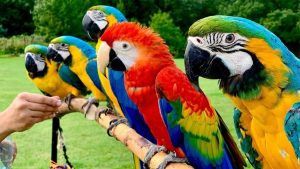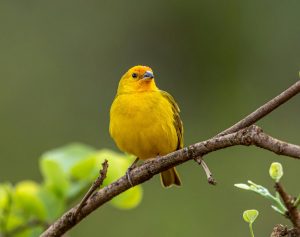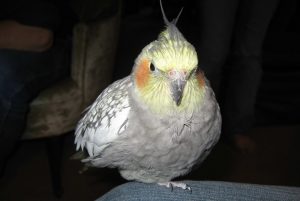With their small size and friendly personality, Budgerigars (often called budgies) have won the hearts of many pet lovers. Not only are they easy to care for, but this type of parrot also brings joy and a sense of connection to the whole family. However, when you decide to get one, it is important to know about their price. So, how much do budgies cost, and how should you raise, care for, and train them? Let’s KnowAllAnimals explore some useful information in the article below.
- Scientific Classification
- Kingdom: Animalia
- Phylum: Chordata
- Class: Aves
- Order: Psittaciformes
- Family: Psittaculidae
- Genus: Melopsittacus Gould, 1840
- Species: M. undulatus

1. The Origin of Budgerigars
The Budgerigar, also known as the Budgie, is a small species of parrot. Its scientific name is Melopsittacus undulatus.
The first budgies were discovered in Hong Kong. Today, they are bred in many countries around the world.
2. Characteristics of Budgerigars
Budgerigars are a small species of parrot. When they reach adulthood, they are only about 18 cm (7 inches) long and have an average lifespan of 7–8 years.
- Their head is quite round, and its size is in proportion to the bird’s body.
- Their beak is very hard, with the upper part being longer than the lower part and tending to hook downwards.
- Their eyes are large, round, and jet-black.
- On the top of their head is a small crest made of very soft and beautiful feathers.
- Their neck is round, large, and thick.
- Their chest is broad, and their back is straight, making them well-proportioned with their overall body.
- Their legs are short and quite large.
- Their toes are large, and their claws are hard and very firm.
- Their tail is quite long and is covered by a layer of long feathers.
Budgies come in many different colors and color combinations. Because of this, there are currently about 50 species of budgies in the world.
3. Budgerigar Temperament
Budgerigars are very friendly, lively, and approachable. They love to interact with humans and can easily build a relationship with their owners over time. This type of parrot has a cheerful personality, is very active, and is highly curious. They love to fly, play, and are easily attracted to small toys.
When you raise a budgie, you’ll see that they enjoy playing with toys like swings, mirrors, or toys with bells. This helps the bird avoid boredom when it has to be alone in its cage.
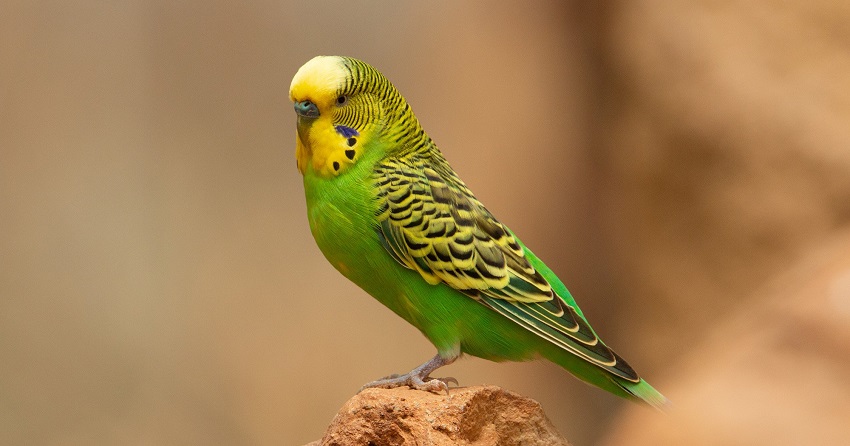
4. Classification of Budgerigar Species
Here are the most common types of budgerigars that are widely kept as pets around the world today:
4.1. Light Green Budgie
This is the most popular type of budgie to own. Their coat is predominantly light green with black markings. Their beak is typically gray. Their legs are usually dark gray. The ring around their eyes is often white, and their forehead is a light yellow. The nose of the male bird turns blue when it reaches adulthood.
4.2. Lutino Budgie
This is a genetically mutated species that was discovered in 1870. This bird has a fluffy coat, and its entire body is a light yellow color. Their eyes are a very distinctive red. The nose of the male bird is often a purplish-red, while the female’s is a brownish-white.
4.3. Gray-Winged Sky Blue Budgie
This type of budgie was found in 1918. Their coat is sky blue with blue-gray stripes. Their tail and wing feathers are quite long and are a lemon-yellow color. The top of their head is white (this only appears in adult birds).
Besides these three characteristic species, budgerigars are also popular in other varieties, such as: gray-green budgies, crested budgies, yellow-faced blue budgies, speckled purple budgies, and cream-yellow budgies.
5. Budgerigar Habitat
This bird species originated in Hong Kong, which is why they are also called Hong Kong parakeets. These birds are very social; they typically form pairs from a young age and are very loyal to their partners.
Paired birds will then form large flocks to live in. Their ideal habitat is in regions with a humid and tropical climate. In Vietnam, budgerigars can be found and are raised in almost every province.
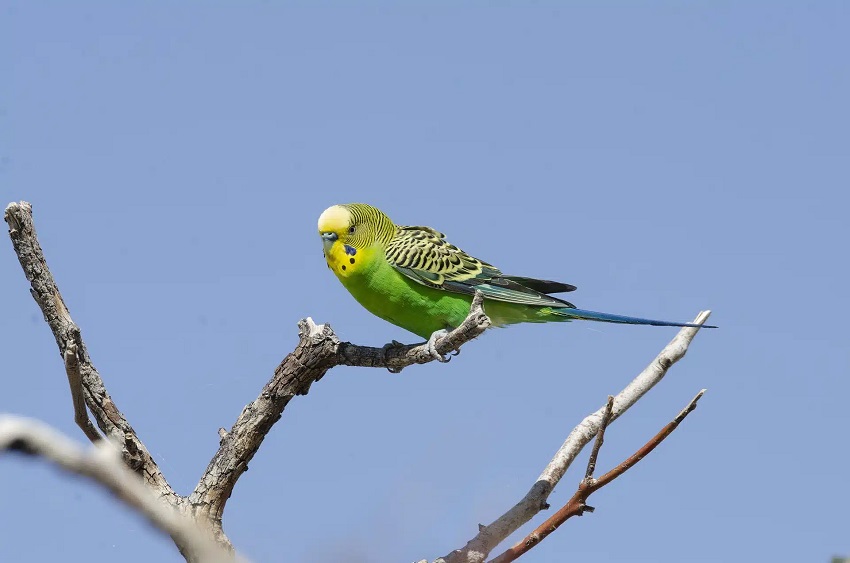
6. Can Budgerigars Talk?
Budgerigars are known to be quite talkative, so much so that some owners might find their constant chattering annoying.
Among parrot species, budgerigars are not the fastest learners. Therefore, if you want to train them to talk, you’ll need to invest more time and effort compared to other parrot breeds.
7. Tips for Raising Budgerigars
This bird species is very easy to care for and has a relatively strong immune system. So, to raise a healthy and beautiful budgie, you just need to keep a few things in mind:
7.1. Budgerigar Cage
The cages used for budgerigars are usually made of metal. Given their strong beaks and natural tendency to chew on wood, a metal cage is a very suitable choice. Moreover, metal cages are much easier to clean.
You should place the cage near plants to give the birds a feeling of being closer to nature. Inside the cage, you need to provide a water bowl, a food bowl, and a perch. If you are breeding them, you should also add a nest box made of thin wood with sawdust inside.
7.2. Budgerigar Food
The diet of a budgerigar is quite varied and rich, and it can be divided into three main categories: dry seeds, fresh vegetables and fruits, and supplements.
- Dry Seeds: Dry seed food for birds typically includes rice, cornmeal, millet, and more. Their favorite type of seed is yellow millet.
- Fresh Vegetables and Fruits: These birds can eat almost all kinds of vegetables (you should remove any bitter ones). You should feed them vegetables like mustard greens, lettuce, and dandelion greens, but they especially love water spinach. You should also supplement their diet with fruits like apples and guavas.
- Supplements: When raising these birds, you should give them crushed oyster shells, crushed eggshells, salt, and grit. Feeding them grit will help them digest their food more easily and prevent food from clumping in their stomachs.
7.3. Budgerigar Health Care
Budgerigars have a very strong immune system, but they can still get sick if they aren’t properly cared for. Therefore, you must regularly clean their cage and wash their food bowls.
Additionally, budgerigars love to bathe (fully submerging in water). So, in the summer, you should give them a bath every two days. In the winter, you should only bathe them on sunny days. After bathing, you need to dry their feathers immediately so they don’t catch a cold.
7.4. Tips for Teaching Budgerigars to Talk
To train a bird to talk well, you need to dedicate a lot of time and effort. You should start training them to talk from a young age (when they are 2–3 months old).
Every day, in the morning and evening, you should go and talk to them. Once they can say basic words, you should have them interact with more people so they can learn to speak with different voices.
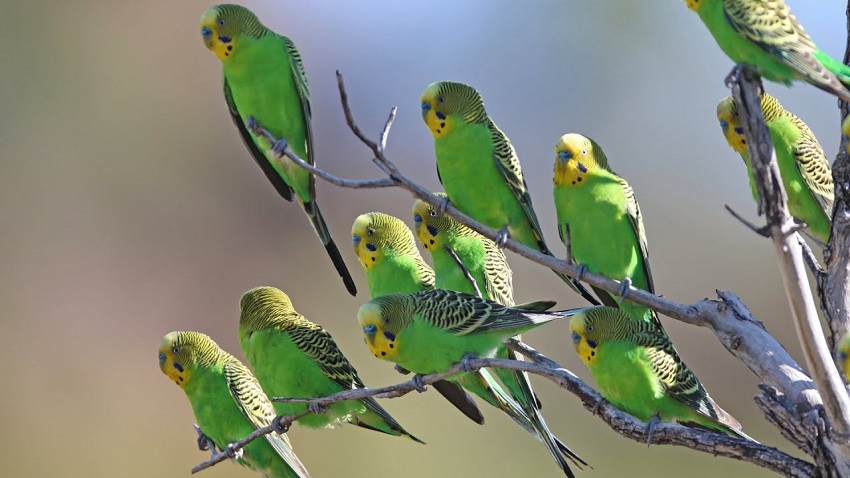
8. How Much Do Budgies Cost?
The price of a budgie is quite affordable, with a pair of birds typically costing between $6 and $15.
9. FAQs
1. Are budgies good pets for beginners?
Yes, budgies are excellent for first-time bird owners. They’re small, friendly, easy to care for, and can even learn to mimic human speech with proper training.
2. What do budgerigars eat?
A balanced diet for budgies includes high-quality seeds or pellets, fresh vegetables (like spinach or carrots), and occasional fruits. Clean water should always be available.
3. Can budgies talk?
Yes, some budgies can learn to mimic words and short phrases, especially if trained consistently from a young age. Males tend to be better talkers than females.
This article summarizes detailed information to answer questions related to the Budgerigar. We hope you’ve gained a clear understanding of the types of food budgies eat and some important feeding tips. We wish you the best in keeping your budgie healthy.
References: https://en.wikipedia.org/wiki/Budgerigar

